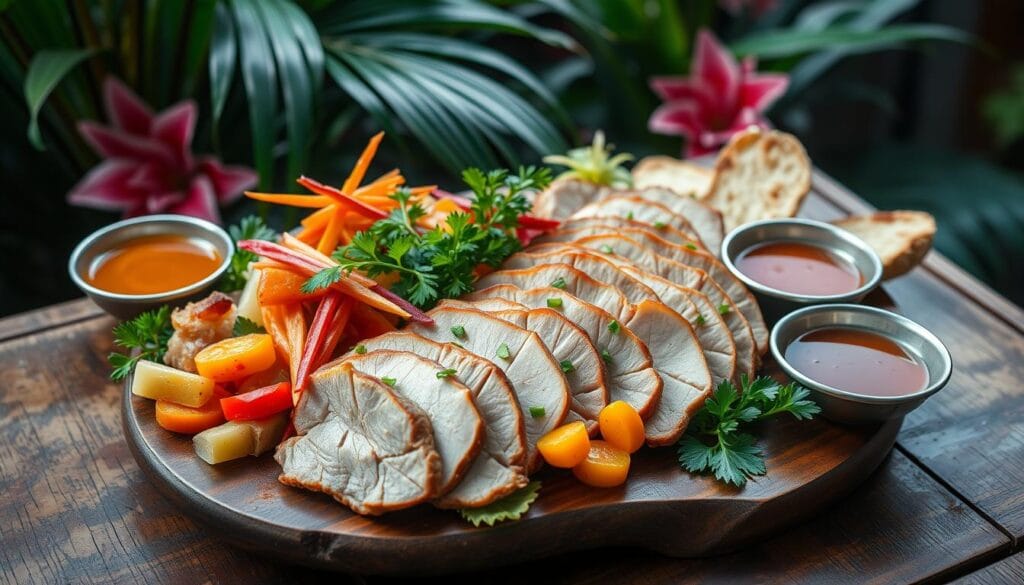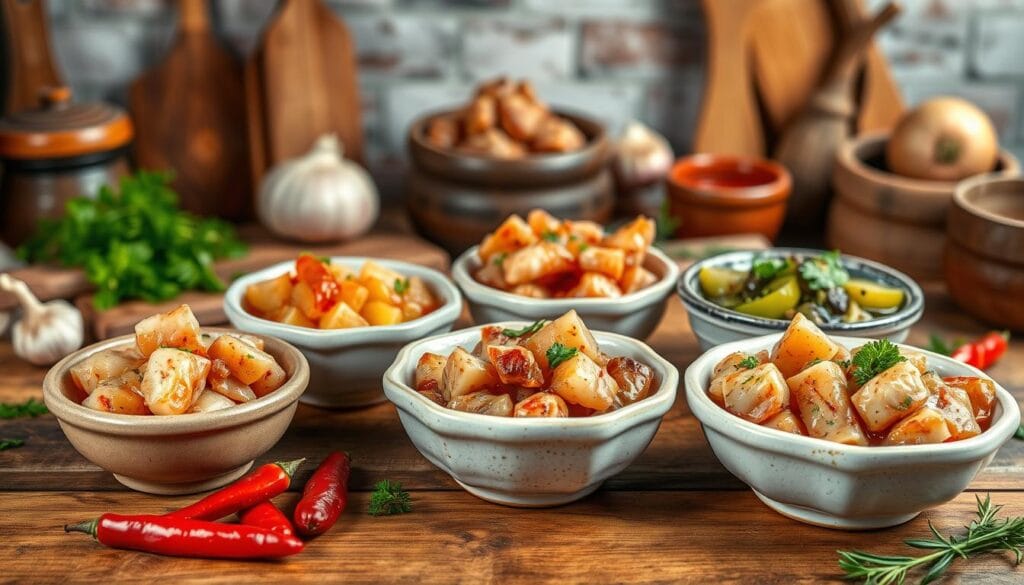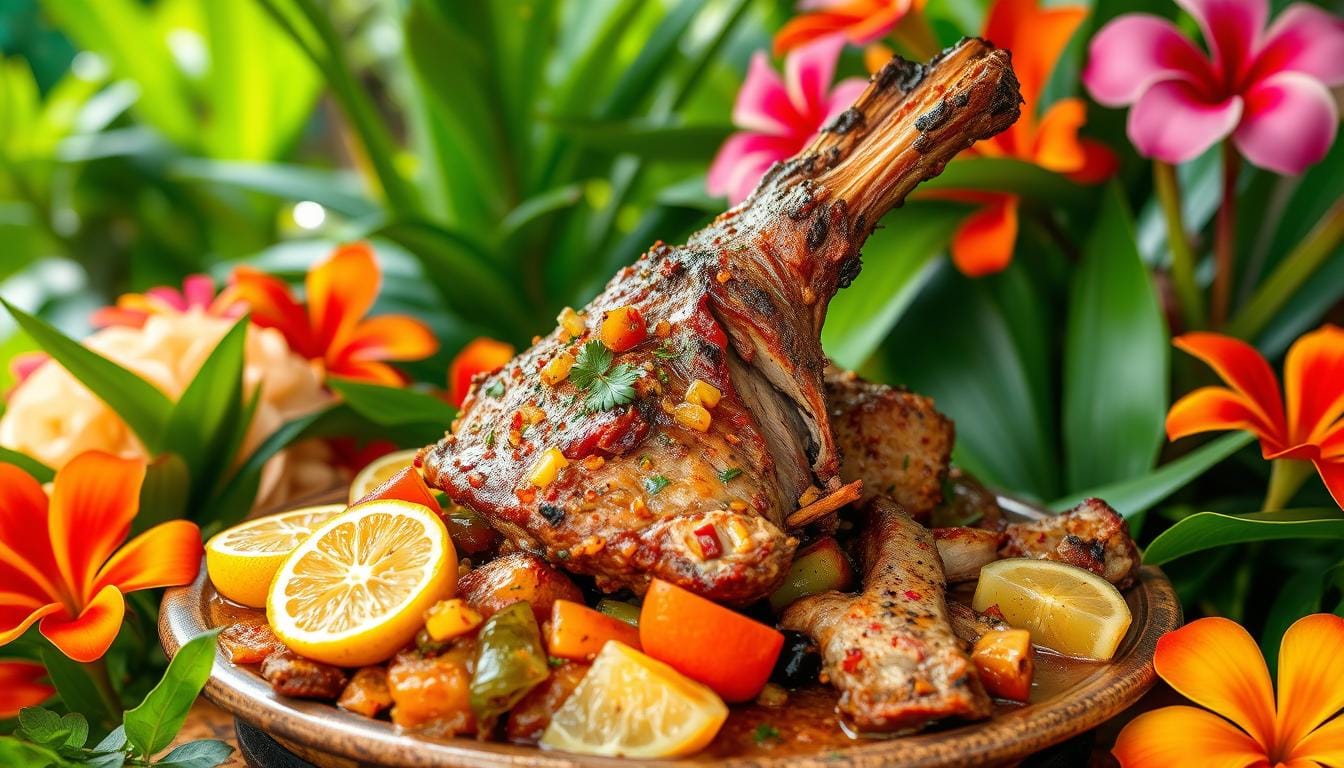Growing up, I loved bold flavors. My first taste of souse meat was unforgettable. It was more than food; it was a cultural journey that opened my eyes to Caribbean cuisine.
Souse meat is a culinary adventure for those who love authentic Caribbean tastes. It turns simple pork into a flavorful dish that tells a story of resilience and creativity. So, what is souse? It’s pickled pork that turns simple ingredients into a memorable meal.
If you enjoy trying new foods, souse meat is a great choice. It’s made with tender pork, marinated in lime juice, cucumbers, and onions. This mix creates a refreshing yet satisfying taste.
Whether you’re a curious foodie or an adventurous eater, souse meat will challenge your taste buds. It invites you to explore the vibrant world of Caribbean flavors. Get ready for a dining experience like no other.
Table of Contents
Understanding the Rich Heritage of Caribbean Souse
Caribbean souse meat is a dish with deep roots in cultural diversity and creative cooking. It came from mixing African, European, and indigenous traditions. This mix turned simple items into a tasty treat.
The history of souse meat starts with using every part of an animal. Caribbean people used this method to make tasty meals from parts that would otherwise be thrown away.
Cultural Significance
Souse meat is a big part of Caribbean food traditions. It’s more than food; it’s a celebration of cultural strength and creativity. Making pork souse is often a highlight of social events and community gatherings.
- Represents historical culinary adaptation
- Symbolizes community and shared cultural experience
- Demonstrates resourceful cooking techniques
Traditional Preparation Methods
Making souse meat the old way means picking and preparing certain cuts of pork. Cooks usually choose parts like pig’s feet, ears, and other less common cuts.
“Souse is not just food, it’s a story of survival and innovation” – Caribbean Culinary Expert
Regional Variations
Each Caribbean island has its own way of making souse meat. They add their own mix of herbs, spices, and marinating methods.
| Island | Souse Meat Characteristic |
|---|---|
| Barbados | Lime juice marinade with cucumber |
| Trinidad | Spicier preparation with local peppers |
| Jamaica | Additional allspice and thyme seasoning |
Learning about souse meat’s rich history helps us understand Caribbean food traditions. It shows how food tells the story of cultural history and community strength.
What Makes Souse Meat Unique
Souse meat is a special dish that turns regular pork into a unique treat. It uses pork parts like feet, ears, and head. This makes it have a special texture and taste that food lovers enjoy.
The way souse meat is made is what makes it special. Recipes call for at least 2 lbs of pork, marinated for hours. This sets it apart from other dishes. The key things that make souse meat unique include:
- Extended marination process (4-8 hours recommended)
- Tangy brine using white vinegar and lime juice
- Unique texture combining tender meat and crisp vegetables
- Cultural significance in Caribbean and Southern cuisine
Souse meat is also very versatile. Its preparation changes a lot depending on where you are. In the Bahamas and Barbados, it’s a weekend favorite. In the Southern United States, it’s called “head cheese.”
“Souse meat is not just a dish, it’s a culinary journey that tells a story of tradition and flavor.”
The way it’s made gives it a special taste. Pickling and herbs and spices mix together to create a complex flavor. Marinating for at least 4 hours lets the meat soak up the brine’s tangy taste.
| Preparation Aspect | Details |
|---|---|
| Prep Time | 30 minutes |
| Cooking Time | 2 hours |
| Marination Time | 4-8 hours |
| Serving Size | 4 people |
Whether you love cooking or just want to try something new, souse meat is a must-try. It combines cultural traditions with amazing flavors.
Essential Ingredients for Authentic Souse Meat
To make delicious souse meat, you need the right ingredients. These ingredients make the dish special. They turn simple parts into a tasty masterpiece.
Primary Meat Components
The base of souse meat is certain meat cuts. They add flavor and softness. Traditionally, these include:
- Pig’s feet (trotters)
- Pig’s ears
- Other offal cuts like tongue or snout
- Chicken wings (alternative protein option)
Herbs and Seasonings
Herbs and spices are key to souse meat’s taste. They make the dish unique:
- Fresh thyme
- Bay leaves
- Hot peppers
- Black pepper
- Garlic
Pickling Solutions
The pickling step is vital. It makes the meat tender and flavorful. The right marinade is essential:
| Ingredient | Quantity | Purpose |
|---|---|---|
| Lime Juice | 1 ½ lemons/limes | Tenderizing meat |
| White Vinegar | ½ cup | Preservation |
| Salt | 1 tablespoon | Seasoning |
Pro tip: Always use fresh citrus and high-quality vinegar for the best souse meat experience.
“The secret to great souse meat lies in the quality of ingredients and the love you put into preparation.”
Step-by-Step Guide to Making Classic Souse Meat
Making souse meat needs patience and focus. It turns simple items into a tasty dish that honors family traditions.
Start by picking the best meat for your souse meat. Pork or chicken is usually the best choice. The steps to make it are important:
- Clean the meat well, removing fat and skin
- Cut it into pieces that are easy to bite
- Make a pickling mix with important ingredients
- Let the meat soak in the mix to soak up flavors
The pickling mix is key for the tangy taste. You’ll need:
- Fresh lime juice (about 1/4 cup)
- Chopped onions
- Allspice berries (6-8 berries)
- Salt and pepper to taste
“The secret to perfect souse meat lies in the marinade and patience during preparation.”
Marinating time is key for flavor. Let the meat soak for 2-3 hours, or even better, overnight in the fridge.
| Ingredient | Quantity | Purpose |
|---|---|---|
| Meat | 2 pounds | Primary protein |
| Lime Juice | 1/4 cup | Tenderizing and flavor |
| Onions | 2 medium | Aromatic base |
When cooking, simmer it gently to keep it tender. It takes about 35 minutes to make, serving 16 half-cup portions.
Health Benefits and Nutritional Value
Souse meat is more than a tasty Caribbean dish. It’s packed with nutrients and proteins. This makes it a great choice for your health.
Protein Content and Mineral Breakdown
Souse meat is a nutritional powerhouse. It comes from pig trotters and other parts. It’s full of protein and important minerals.
- High protein content: Approximately 16 grams per 100 grams
- Rich in essential minerals like zinc and phosphorus
- Contains approximately 250 calories per 100 grams
Dietary Considerations
While souse meat is nutritious, it’s high in fat. It has about 20 grams of fat per 100 grams. People watching their fat intake should eat it in small amounts.
“Souse meat represents a traditional protein source with complex nutritional characteristics” – Caribbean Culinary Experts
Those with special diets should watch the sodium and fat in souse meat. The pickling process adds extra sodium.
Unique Nutritional Components
Souse meat is special because of its collagen. It’s made from pig’s head, ears, and trotters. This means it’s good for your joints.
Serving Suggestions and Pairings

Discovering the perfect way to serve souse meat can transform your culinary experience. This Caribbean delicacy offers versatile serving options that will delight your taste buds and impress your guests.
Traditional serving styles for souse meat include:
- Chilled as an appetizer with crisp vegetables
- Served alongside rice and peas
- Paired with fresh bread or crackers
- Incorporated into light salads
When preparing pork souse, consider these exciting pairing suggestions:
- Beverage Pairings
- Rum-based cocktails
- Cold beer
- Sparkling water with citrus
- Side Dish Recommendations
- Fried plantains
- Green salad
- Pickled vegetables
“Souse meat is not just a dish, it’s a celebration of Caribbean culinary tradition!” – Caribbean Food Expert
For a truly authentic experience, serve your souse meat chilled and garnished with fresh herbs. This approach highlights the meat’s delicate flavor and ensures a refreshing dining experience that captures the essence of Caribbean cuisine.
Storage Tips and Preservation Methods
Keeping souse meat fresh is key. Knowing how to store it right ensures you enjoy its great taste and texture.
Refrigeration Guidelines
Storing souse meat needs careful attention. It should be kept at 0°C to 4°C. Here are some tips:
- Use airtight containers to prevent moisture loss
- Store in the coldest part of your refrigerator
- Keep souse meat away from raw meats to prevent cross-contamination
Shelf Life Information
The shelf life of souse meat depends on how you store it. Vacuum sealing can make it last longer than regular storage.
| Storage Method | Refrigerator Shelf Life | Freezer Shelf Life |
|---|---|---|
| Vacuum Sealed | Up to 7-10 days | 12-24 months |
| Traditional Packaging | 3-5 days | 4-6 months |
“Preservation is an art that transforms souse meat from a simple dish to a culinary treasure.” – Culinary Expert
For the best preservation, try these advanced methods:
- Use modified atmosphere packaging (MAP) to reduce bacterial growth
- Implement vacuum sealing to minimize oxidation
- Monitor storage temperatures consistently
Pro tip: Always check for signs of spoilage like unusual odor, discoloration, or texture changes before consuming stored souse meat.
Common Variations of Souse Meat Recipes
Exploring souse meat recipes opens up a world of flavors. From the Caribbean to Europe, each place has its own twist. These variations add unique tastes and cooking methods to this classic dish.

Different cultures have made their own souse meat recipes. This shows how versatile this traditional dish can be. Let’s look at some interesting variations:
- Trinidadian Souse: A zesty version using chicken feet, lime, cucumber, and hot peppers
- Polish Salceson: A gelatinous pork preparation with garlic and simmered meat cuts
- German Presskopf: Features larger meat chunks and robust spices
- Greek Pichti: Utilizes pig’s head and feet with garlic and oregano
The hog head souse recipe is especially interesting. Southern-style recipes have two main types:
- Mild souse meat: A creamy, subtly seasoned option
- Hot souse meat: A spicy version with pepper-infused gelatin
“Souse meat is more than a dish—it’s a culinary adventure that tells the story of cultural traditions.” – Culinary Historian
| Variation | Key Ingredients | Unique Characteristic |
|---|---|---|
| Chicken Souse | Chicken wings, allspice, limes | Popular hangover remedy |
| Bahamian Souse | Served with johnny cakes | Traditional island preparation |
| French Fromage de Tête | Pig’s head, aromatic vegetables | Smooth, pureed texture |
Trying out different souse meat recipes is a flavorful journey. It lets you explore new tastes while honoring old traditions. Whether you like it mild or spicy, there’s a souse recipe for you.
Tips for Selecting Quality Ingredients
Making delicious souse meat starts with top-notch ingredients. Your success in making this Caribbean dish depends on picking the right parts. These parts should boost flavor and keep the dish true to its roots.
When you’re learning to make souse meat, remember these key tips:
- Meat Quality: Go for fresh pork with little fat and a bright pink color.
- Citrus Freshness: Choose ripe, juicy limes with bright green skin.
- Herb Selection: Pick crisp, aromatic herbs like cilantro and parsley.
- Vegetable Condition: Opt for firm, unblemished cucumbers and onions.
Fresh ingredients are key to making your souse meat stand out. Around 30% of an ingredient’s flavor can be lost if not fresh. So, picking carefully is very important.
| Ingredient Category | Quality Indicators | Recommended Source |
|---|---|---|
| Pork Cuts | Firm texture, minimal odor | Local butcher shops |
| Citrus | Bright color, heavy for size | Farmers markets |
| Herbs | Vibrant green, no wilting | Organic produce stores |
“Quality ingredients transform good dishes into culinary masterpieces.” – Caribbean Culinary Experts
By focusing on quality ingredients, you’ll make a flavorful, authentic souse meat. This dish will honor the traditional Caribbean cooking ways.
Conclusion
Exploring what is souse has been a journey into the heart of Caribbean culture. It shows how traditional cooking meets nutritional value. From Barbados to the US, souse meat opens a door to authentic tastes and old ways of cooking.
Your exploration of souse meat has shown its many sides. It’s not just about its protein or cultural importance. It’s a chance to learn about new flavors and cooking techniques from the Caribbean.
Thinking about making souse meat at home? Each recipe has its own story. Mixing pork, vinegar, lime, and herbs makes a dish that’s truly special. With the right storage and knowledge of its health benefits, you can enjoy this tradition in your kitchen.
Souse meat is more than food; it’s a celebration of culture, skill, and new tastes. By trying dishes like souse, you connect with traditions and global flavors. It’s a way to experience the world through food.

